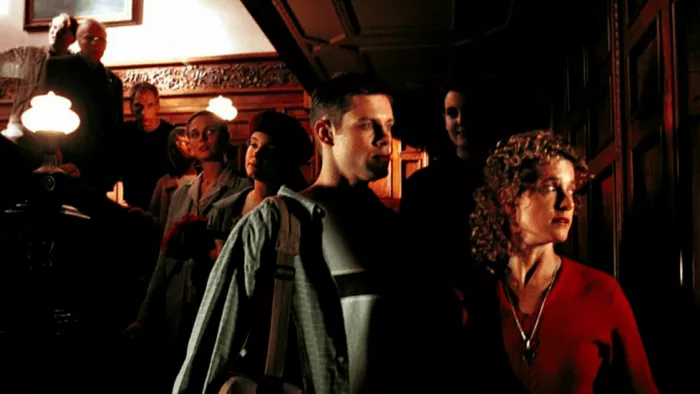Rose Red, a 2002 television miniseries, has long intrigued audiences with its haunting narrative and eerie atmosphere. Many viewers have wondered whether this chilling tale is based on a Stephen King novel, given the author’s reputation for crafting spine-tingling stories. In this article, we will delve into the origins of Rose Red, its inspirations, and the deliberate marketing strategy that blurred the lines between fiction and reality, ultimately proving that it is not a Stephen King adaptation.
Shirley Jackson’s The Haunting of Hill House: The True Inspiration
While Rose Red may evoke Stephen King’s name due to its horror genre and supernatural elements, it is not a direct adaptation of his work. Instead, the miniseries draws inspiration from another literary masterpiece: Shirley Jackson’s The Haunting of Hill House. Jackson’s novel, published in 1959, is a quintessential example of the haunted house genre and has left an indelible mark on horror literature. Rose Red shares thematic and narrative similarities with Jackson’s story, primarily in its portrayal of a sprawling mansion with a dark history, a team of paranormal investigators, and the exploration of psychological horror.
The connection between Rose Red and Shirley Jackson’s work runs deeper than surface-level similarities. Both narratives explore the concept of a haunted house as a character in its own right, with malevolent forces lurking within its walls. The mansion in Rose Red mirrors the eerie and enigmatic Hill House in Jackson’s novel, with both settings serving as catalysts for the unraveling of the characters’ sanity. The psychological horror that ensues, where the boundaries between the supernatural and the characters’ psyches blur, is a testament to Jackson’s enduring influence on the genre.
Parallels to the Winchester Mystery House
In addition to Shirley Jackson’s influence, Rose Red also draws parallels to the real-world Winchester Mystery House, located in San Jose, California. The Winchester Mystery House is renowned for its labyrinthine architecture, featuring staircases that lead to nowhere, doors that open into walls, and a design seemingly intended to confuse spirits. Rose Red incorporates similar architectural eccentricities, creating an eerie and unsettling atmosphere within the mansion. While the Winchester Mystery House is not a direct source of inspiration, its influence on the series is evident in the design of the titular mansion.
The incorporation of architectural oddities reminiscent of the Winchester Mystery House adds an intriguing layer of authenticity to Rose Red. These architectural quirks contribute to the mansion’s ominous aura, reinforcing the idea that it has a malevolent presence of its own. Just as the Winchester Mystery House has captivated visitors with its peculiar design and whispered tales of hauntings, Rose Red‘s portrayal of the mansion entices viewers into a world where the boundaries of reality and the supernatural are fluid and disorienting.
Marketing that Blurred Fiction and Reality
One of the most intriguing aspects of Rose Red is its marketing strategy, which intentionally blurred the lines between fiction and reality. To promote the series, a tie-in book titled “The Diary of Ellen Rimbauer” was published. This fictional diary purportedly belonged to the wife of Rose Red‘s creator, John Rimbauer, and offered a detailed account of life at the mansion. Additionally, a fake university website for the “Rimbauer Institute” was created, further reinforcing the illusion that Rose Red was based on true events. This innovative marketing approach successfully captivated audiences and added an extra layer of mystery to the series.
The marketing campaign for Rose Red was a stroke of genius that immersed viewers in a world of intrigue and deception. By presenting the tie-in book and the fake university website as authentic supplements to the series, the creators effectively blurred the lines between fiction and reality. Readers of “The Diary of Ellen Rimbauer” were drawn into the fictitious history of the mansion, while visitors to the Rimbauer Institute website found themselves navigating a web of fabricated information. This immersive experience heightened the anticipation and curiosity surrounding the miniseries, making it all the more compelling.
Tapping into Familiar Themes
Rose Red‘s appeal and familiarity to viewers may stem from its tapping into timeless themes that have pervaded ghost stories and haunted house legends for centuries. The concept of a malevolent house, restless spirits, and paranormal investigations resonates with the core elements of urban legends and folklore. These themes have a universal quality, making them instantly relatable to audiences and contributing to the enduring popularity of stories like Rose Red.
The enduring allure of Rose Red lies in its ability to tap into the universal fascination with the supernatural and the unknown. Ghost stories and haunted houses have been a staple of human storytelling for generations, with each culture offering its own unique spin on these enduring themes. Rose Red capitalizes on this fascination by presenting a narrative that echoes the age-old tales of spectral encounters and haunted locales. The series taps into the primal fear of the unseen, the eerie noises in the dark, and the idea that places can retain the echoes of past traumas, a concept deeply ingrained in our collective consciousness.
Conclusion: Rose Red—A Unique Blend of Inspirations
In summary, Rose Red is not a Stephen King adaptation but rather a unique blend of inspirations drawn from Shirley Jackson’s The Haunting of Hill House, the enigmatic architecture of the Winchester Mystery House, and a marketing strategy that blurred the lines between fiction and reality. Its deliberate marketing strategy, which blurred the lines between fiction and reality, added an intriguing layer to the viewing experience. Rose Red taps into familiar themes that have made ghost stories and haunted houses a staple in the realm of urban legends and folklore. While it may not bear King’s name, Rose Red remains a captivating and chilling addition to the world of supernatural horror, showcasing the enduring power of classic themes in the horror genre.

